Consumer Decision-Making Process and Insight Report at TESCO
VerifiedAdded on 2021/02/19
|15
|4168
|243
Report
AI Summary
This report provides a comprehensive analysis of consumer behaviour and decision-making processes, focusing on the retail giant TESCO's strategies. It begins with an overview of the various stages involved in consumer decision-making, including problem identification, information gathering, alternative evaluation, and purchase decisions. The report then emphasizes the importance of mapping the consumer's journey to understand their choices, followed by an examination of the decision-making process for a specific commodity or service. Furthermore, it delves into the concepts and models of consumer decision-making, contrasting B2B and B2C approaches, and explores market research methodologies and their impact on decision-making. The report also investigates the factors that influence consumer decisions and assesses how marketers strategically impact each stage of the process, providing a critical evaluation of these influences. Overall, the report offers valuable insights into consumer behaviour and the strategies companies use to navigate the complex world of consumer choices.
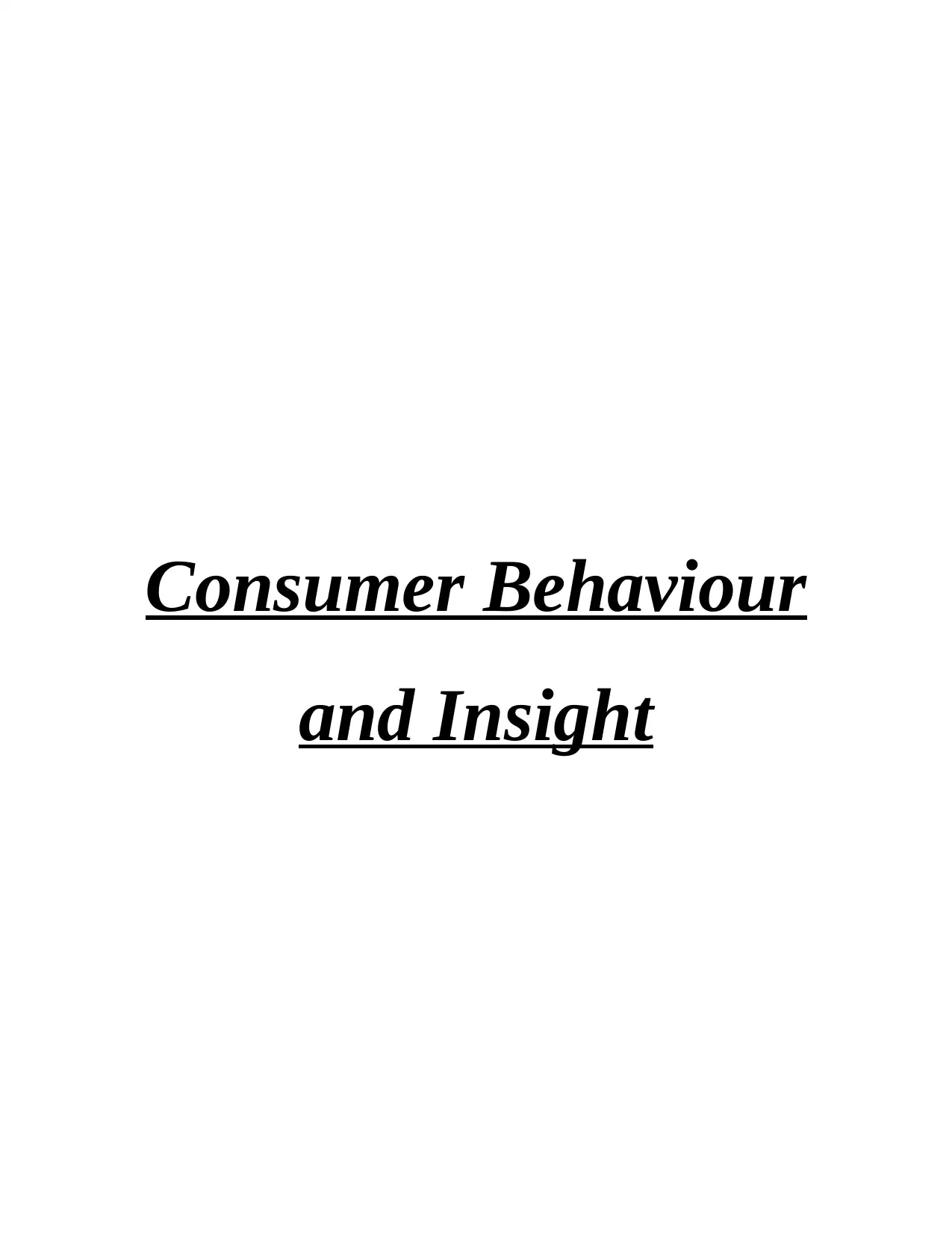
Consumer Behaviour
and Insight
and Insight
Paraphrase This Document
Need a fresh take? Get an instant paraphrase of this document with our AI Paraphraser
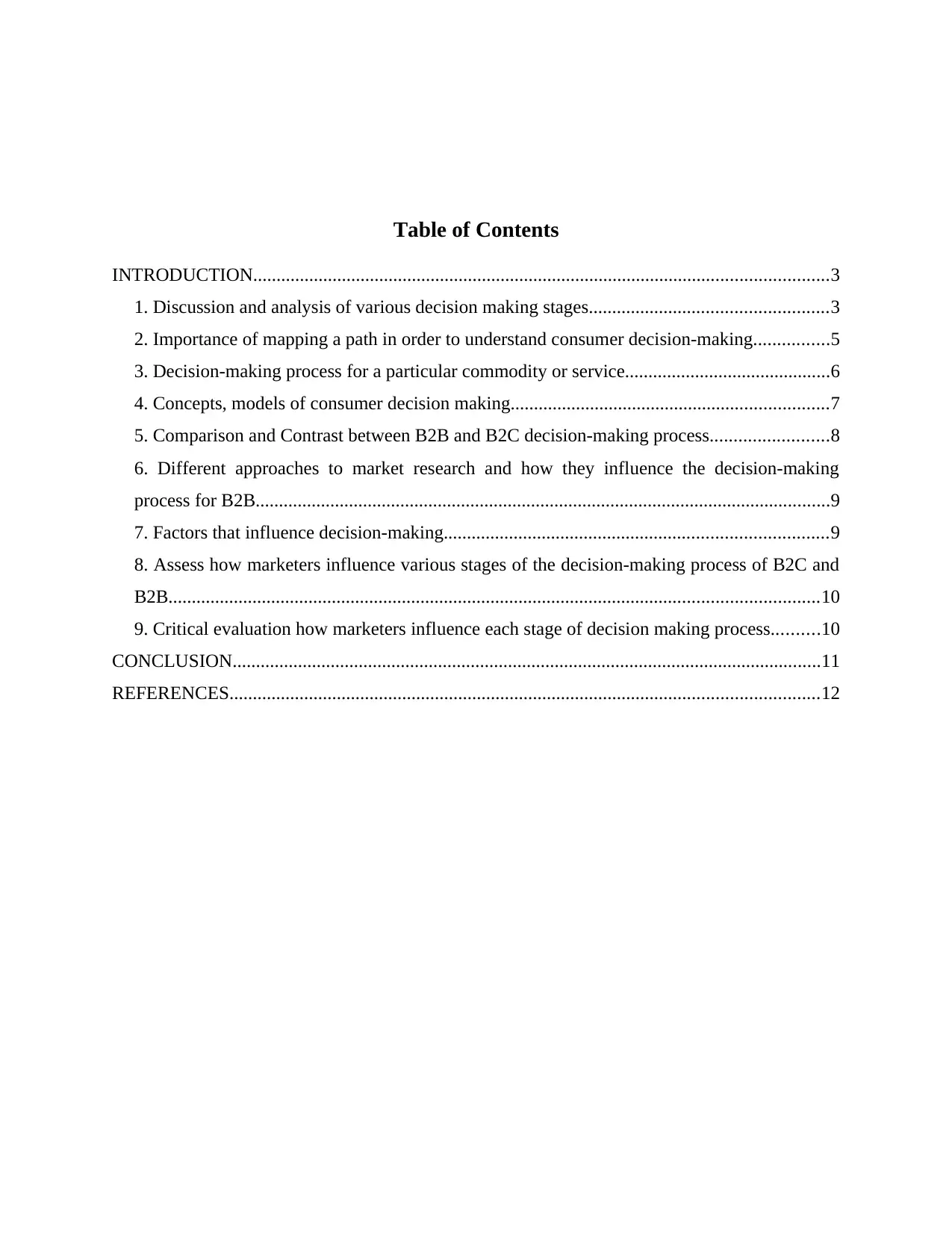
Table of Contents
INTRODUCTION...........................................................................................................................3
1. Discussion and analysis of various decision making stages...................................................3
2. Importance of mapping a path in order to understand consumer decision-making................5
3. Decision-making process for a particular commodity or service............................................6
4. Concepts, models of consumer decision making....................................................................7
5. Comparison and Contrast between B2B and B2C decision-making process.........................8
6. Different approaches to market research and how they influence the decision-making
process for B2B...........................................................................................................................9
7. Factors that influence decision-making..................................................................................9
8. Assess how marketers influence various stages of the decision-making process of B2C and
B2B...........................................................................................................................................10
9. Critical evaluation how marketers influence each stage of decision making process..........10
CONCLUSION..............................................................................................................................11
REFERENCES..............................................................................................................................12
INTRODUCTION...........................................................................................................................3
1. Discussion and analysis of various decision making stages...................................................3
2. Importance of mapping a path in order to understand consumer decision-making................5
3. Decision-making process for a particular commodity or service............................................6
4. Concepts, models of consumer decision making....................................................................7
5. Comparison and Contrast between B2B and B2C decision-making process.........................8
6. Different approaches to market research and how they influence the decision-making
process for B2B...........................................................................................................................9
7. Factors that influence decision-making..................................................................................9
8. Assess how marketers influence various stages of the decision-making process of B2C and
B2B...........................................................................................................................................10
9. Critical evaluation how marketers influence each stage of decision making process..........10
CONCLUSION..............................................................................................................................11
REFERENCES..............................................................................................................................12
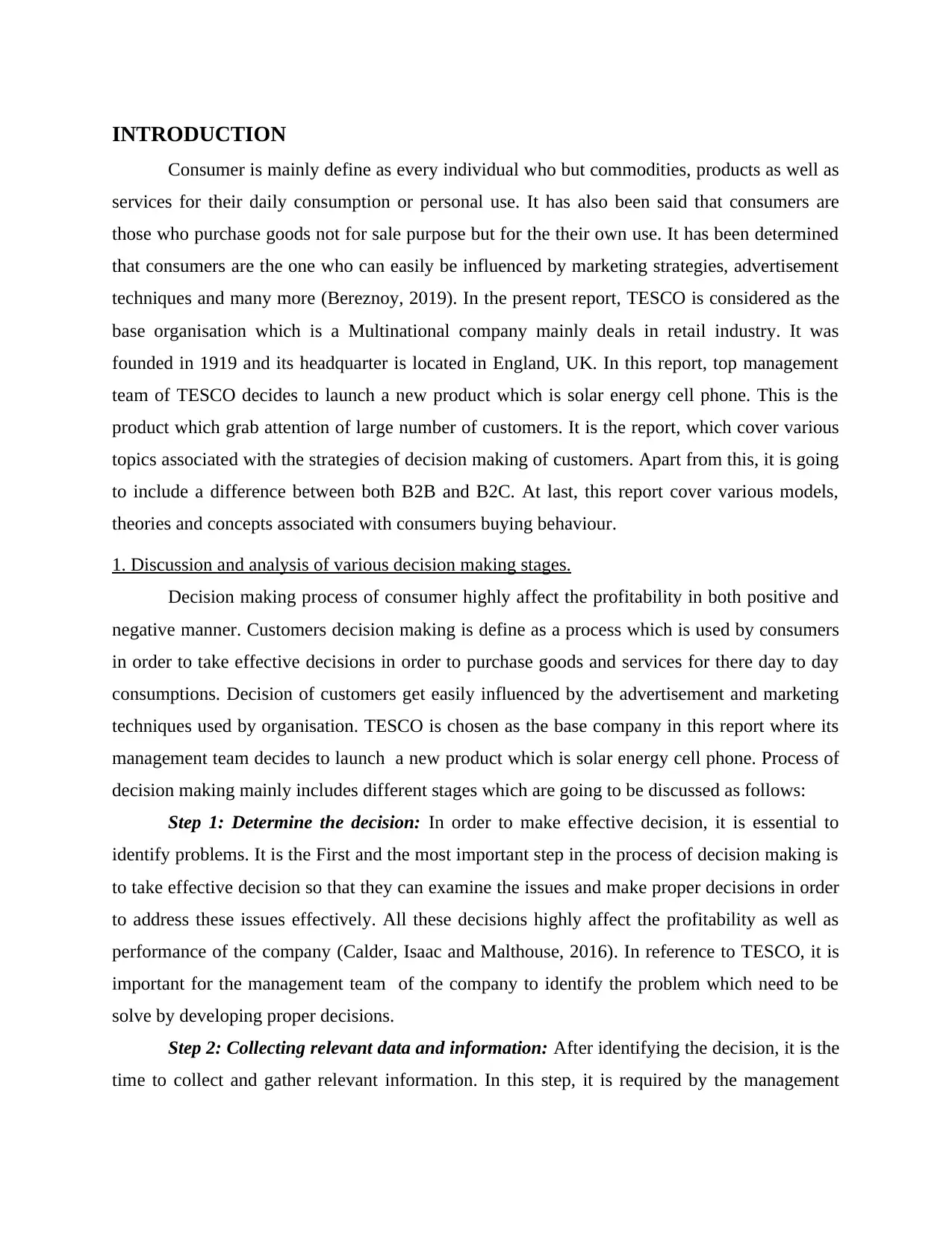
INTRODUCTION
Consumer is mainly define as every individual who but commodities, products as well as
services for their daily consumption or personal use. It has also been said that consumers are
those who purchase goods not for sale purpose but for the their own use. It has been determined
that consumers are the one who can easily be influenced by marketing strategies, advertisement
techniques and many more (Bereznoy, 2019). In the present report, TESCO is considered as the
base organisation which is a Multinational company mainly deals in retail industry. It was
founded in 1919 and its headquarter is located in England, UK. In this report, top management
team of TESCO decides to launch a new product which is solar energy cell phone. This is the
product which grab attention of large number of customers. It is the report, which cover various
topics associated with the strategies of decision making of customers. Apart from this, it is going
to include a difference between both B2B and B2C. At last, this report cover various models,
theories and concepts associated with consumers buying behaviour.
1. Discussion and analysis of various decision making stages.
Decision making process of consumer highly affect the profitability in both positive and
negative manner. Customers decision making is define as a process which is used by consumers
in order to take effective decisions in order to purchase goods and services for there day to day
consumptions. Decision of customers get easily influenced by the advertisement and marketing
techniques used by organisation. TESCO is chosen as the base company in this report where its
management team decides to launch a new product which is solar energy cell phone. Process of
decision making mainly includes different stages which are going to be discussed as follows:
Step 1: Determine the decision: In order to make effective decision, it is essential to
identify problems. It is the First and the most important step in the process of decision making is
to take effective decision so that they can examine the issues and make proper decisions in order
to address these issues effectively. All these decisions highly affect the profitability as well as
performance of the company (Calder, Isaac and Malthouse, 2016). In reference to TESCO, it is
important for the management team of the company to identify the problem which need to be
solve by developing proper decisions.
Step 2: Collecting relevant data and information: After identifying the decision, it is the
time to collect and gather relevant information. In this step, it is required by the management
Consumer is mainly define as every individual who but commodities, products as well as
services for their daily consumption or personal use. It has also been said that consumers are
those who purchase goods not for sale purpose but for the their own use. It has been determined
that consumers are the one who can easily be influenced by marketing strategies, advertisement
techniques and many more (Bereznoy, 2019). In the present report, TESCO is considered as the
base organisation which is a Multinational company mainly deals in retail industry. It was
founded in 1919 and its headquarter is located in England, UK. In this report, top management
team of TESCO decides to launch a new product which is solar energy cell phone. This is the
product which grab attention of large number of customers. It is the report, which cover various
topics associated with the strategies of decision making of customers. Apart from this, it is going
to include a difference between both B2B and B2C. At last, this report cover various models,
theories and concepts associated with consumers buying behaviour.
1. Discussion and analysis of various decision making stages.
Decision making process of consumer highly affect the profitability in both positive and
negative manner. Customers decision making is define as a process which is used by consumers
in order to take effective decisions in order to purchase goods and services for there day to day
consumptions. Decision of customers get easily influenced by the advertisement and marketing
techniques used by organisation. TESCO is chosen as the base company in this report where its
management team decides to launch a new product which is solar energy cell phone. Process of
decision making mainly includes different stages which are going to be discussed as follows:
Step 1: Determine the decision: In order to make effective decision, it is essential to
identify problems. It is the First and the most important step in the process of decision making is
to take effective decision so that they can examine the issues and make proper decisions in order
to address these issues effectively. All these decisions highly affect the profitability as well as
performance of the company (Calder, Isaac and Malthouse, 2016). In reference to TESCO, it is
important for the management team of the company to identify the problem which need to be
solve by developing proper decisions.
Step 2: Collecting relevant data and information: After identifying the decision, it is the
time to collect and gather relevant information. In this step, it is required by the management
⊘ This is a preview!⊘
Do you want full access?
Subscribe today to unlock all pages.

Trusted by 1+ million students worldwide
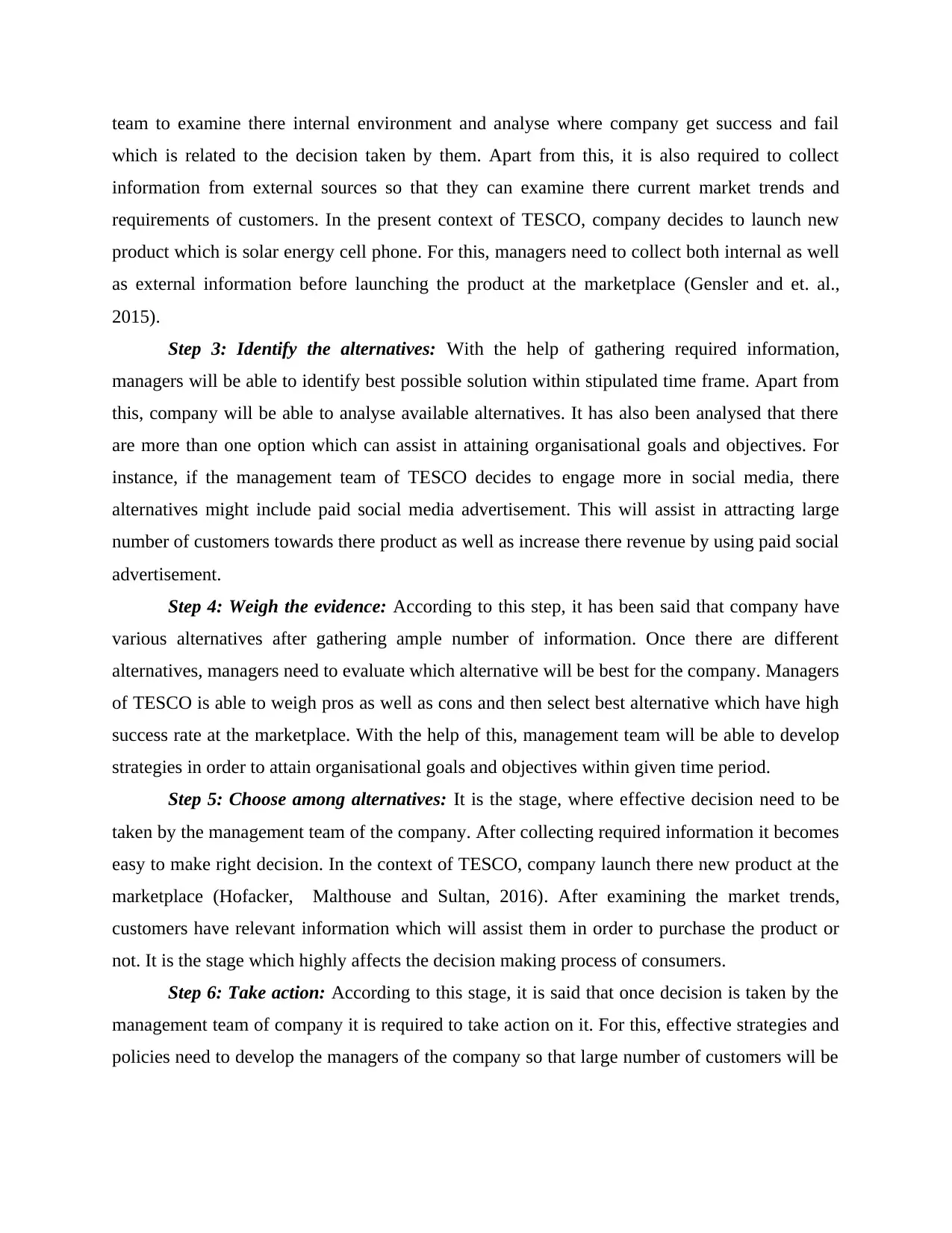
team to examine there internal environment and analyse where company get success and fail
which is related to the decision taken by them. Apart from this, it is also required to collect
information from external sources so that they can examine there current market trends and
requirements of customers. In the present context of TESCO, company decides to launch new
product which is solar energy cell phone. For this, managers need to collect both internal as well
as external information before launching the product at the marketplace (Gensler and et. al.,
2015).
Step 3: Identify the alternatives: With the help of gathering required information,
managers will be able to identify best possible solution within stipulated time frame. Apart from
this, company will be able to analyse available alternatives. It has also been analysed that there
are more than one option which can assist in attaining organisational goals and objectives. For
instance, if the management team of TESCO decides to engage more in social media, there
alternatives might include paid social media advertisement. This will assist in attracting large
number of customers towards there product as well as increase there revenue by using paid social
advertisement.
Step 4: Weigh the evidence: According to this step, it has been said that company have
various alternatives after gathering ample number of information. Once there are different
alternatives, managers need to evaluate which alternative will be best for the company. Managers
of TESCO is able to weigh pros as well as cons and then select best alternative which have high
success rate at the marketplace. With the help of this, management team will be able to develop
strategies in order to attain organisational goals and objectives within given time period.
Step 5: Choose among alternatives: It is the stage, where effective decision need to be
taken by the management team of the company. After collecting required information it becomes
easy to make right decision. In the context of TESCO, company launch there new product at the
marketplace (Hofacker, Malthouse and Sultan, 2016). After examining the market trends,
customers have relevant information which will assist them in order to purchase the product or
not. It is the stage which highly affects the decision making process of consumers.
Step 6: Take action: According to this stage, it is said that once decision is taken by the
management team of company it is required to take action on it. For this, effective strategies and
policies need to develop the managers of the company so that large number of customers will be
which is related to the decision taken by them. Apart from this, it is also required to collect
information from external sources so that they can examine there current market trends and
requirements of customers. In the present context of TESCO, company decides to launch new
product which is solar energy cell phone. For this, managers need to collect both internal as well
as external information before launching the product at the marketplace (Gensler and et. al.,
2015).
Step 3: Identify the alternatives: With the help of gathering required information,
managers will be able to identify best possible solution within stipulated time frame. Apart from
this, company will be able to analyse available alternatives. It has also been analysed that there
are more than one option which can assist in attaining organisational goals and objectives. For
instance, if the management team of TESCO decides to engage more in social media, there
alternatives might include paid social media advertisement. This will assist in attracting large
number of customers towards there product as well as increase there revenue by using paid social
advertisement.
Step 4: Weigh the evidence: According to this step, it has been said that company have
various alternatives after gathering ample number of information. Once there are different
alternatives, managers need to evaluate which alternative will be best for the company. Managers
of TESCO is able to weigh pros as well as cons and then select best alternative which have high
success rate at the marketplace. With the help of this, management team will be able to develop
strategies in order to attain organisational goals and objectives within given time period.
Step 5: Choose among alternatives: It is the stage, where effective decision need to be
taken by the management team of the company. After collecting required information it becomes
easy to make right decision. In the context of TESCO, company launch there new product at the
marketplace (Hofacker, Malthouse and Sultan, 2016). After examining the market trends,
customers have relevant information which will assist them in order to purchase the product or
not. It is the stage which highly affects the decision making process of consumers.
Step 6: Take action: According to this stage, it is said that once decision is taken by the
management team of company it is required to take action on it. For this, effective strategies and
policies need to develop the managers of the company so that large number of customers will be
Paraphrase This Document
Need a fresh take? Get an instant paraphrase of this document with our AI Paraphraser
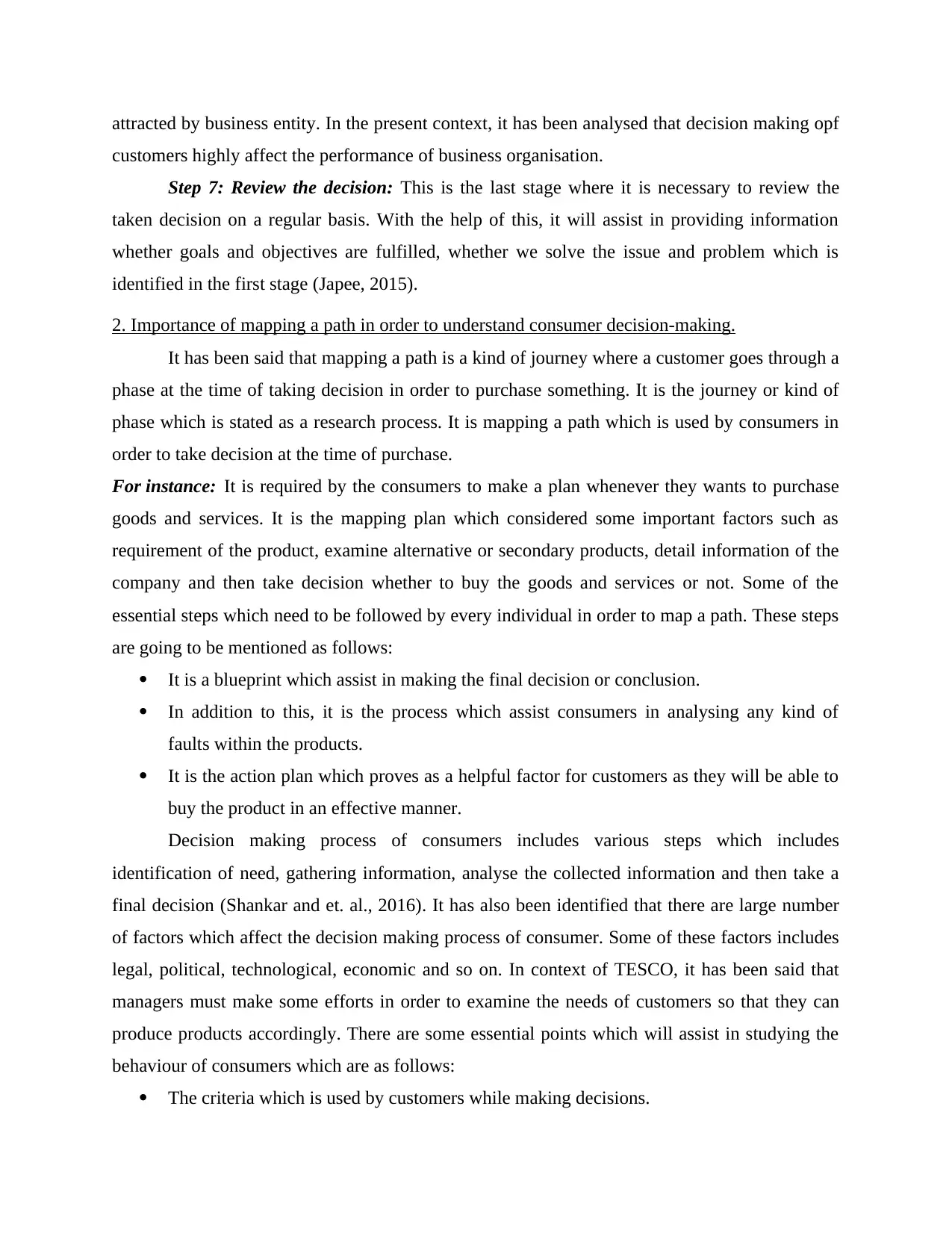
attracted by business entity. In the present context, it has been analysed that decision making opf
customers highly affect the performance of business organisation.
Step 7: Review the decision: This is the last stage where it is necessary to review the
taken decision on a regular basis. With the help of this, it will assist in providing information
whether goals and objectives are fulfilled, whether we solve the issue and problem which is
identified in the first stage (Japee, 2015).
2. Importance of mapping a path in order to understand consumer decision-making.
It has been said that mapping a path is a kind of journey where a customer goes through a
phase at the time of taking decision in order to purchase something. It is the journey or kind of
phase which is stated as a research process. It is mapping a path which is used by consumers in
order to take decision at the time of purchase.
For instance: It is required by the consumers to make a plan whenever they wants to purchase
goods and services. It is the mapping plan which considered some important factors such as
requirement of the product, examine alternative or secondary products, detail information of the
company and then take decision whether to buy the goods and services or not. Some of the
essential steps which need to be followed by every individual in order to map a path. These steps
are going to be mentioned as follows:
It is a blueprint which assist in making the final decision or conclusion.
In addition to this, it is the process which assist consumers in analysing any kind of
faults within the products.
It is the action plan which proves as a helpful factor for customers as they will be able to
buy the product in an effective manner.
Decision making process of consumers includes various steps which includes
identification of need, gathering information, analyse the collected information and then take a
final decision (Shankar and et. al., 2016). It has also been identified that there are large number
of factors which affect the decision making process of consumer. Some of these factors includes
legal, political, technological, economic and so on. In context of TESCO, it has been said that
managers must make some efforts in order to examine the needs of customers so that they can
produce products accordingly. There are some essential points which will assist in studying the
behaviour of consumers which are as follows:
The criteria which is used by customers while making decisions.
customers highly affect the performance of business organisation.
Step 7: Review the decision: This is the last stage where it is necessary to review the
taken decision on a regular basis. With the help of this, it will assist in providing information
whether goals and objectives are fulfilled, whether we solve the issue and problem which is
identified in the first stage (Japee, 2015).
2. Importance of mapping a path in order to understand consumer decision-making.
It has been said that mapping a path is a kind of journey where a customer goes through a
phase at the time of taking decision in order to purchase something. It is the journey or kind of
phase which is stated as a research process. It is mapping a path which is used by consumers in
order to take decision at the time of purchase.
For instance: It is required by the consumers to make a plan whenever they wants to purchase
goods and services. It is the mapping plan which considered some important factors such as
requirement of the product, examine alternative or secondary products, detail information of the
company and then take decision whether to buy the goods and services or not. Some of the
essential steps which need to be followed by every individual in order to map a path. These steps
are going to be mentioned as follows:
It is a blueprint which assist in making the final decision or conclusion.
In addition to this, it is the process which assist consumers in analysing any kind of
faults within the products.
It is the action plan which proves as a helpful factor for customers as they will be able to
buy the product in an effective manner.
Decision making process of consumers includes various steps which includes
identification of need, gathering information, analyse the collected information and then take a
final decision (Shankar and et. al., 2016). It has also been identified that there are large number
of factors which affect the decision making process of consumer. Some of these factors includes
legal, political, technological, economic and so on. In context of TESCO, it has been said that
managers must make some efforts in order to examine the needs of customers so that they can
produce products accordingly. There are some essential points which will assist in studying the
behaviour of consumers which are as follows:
The criteria which is used by customers while making decisions.
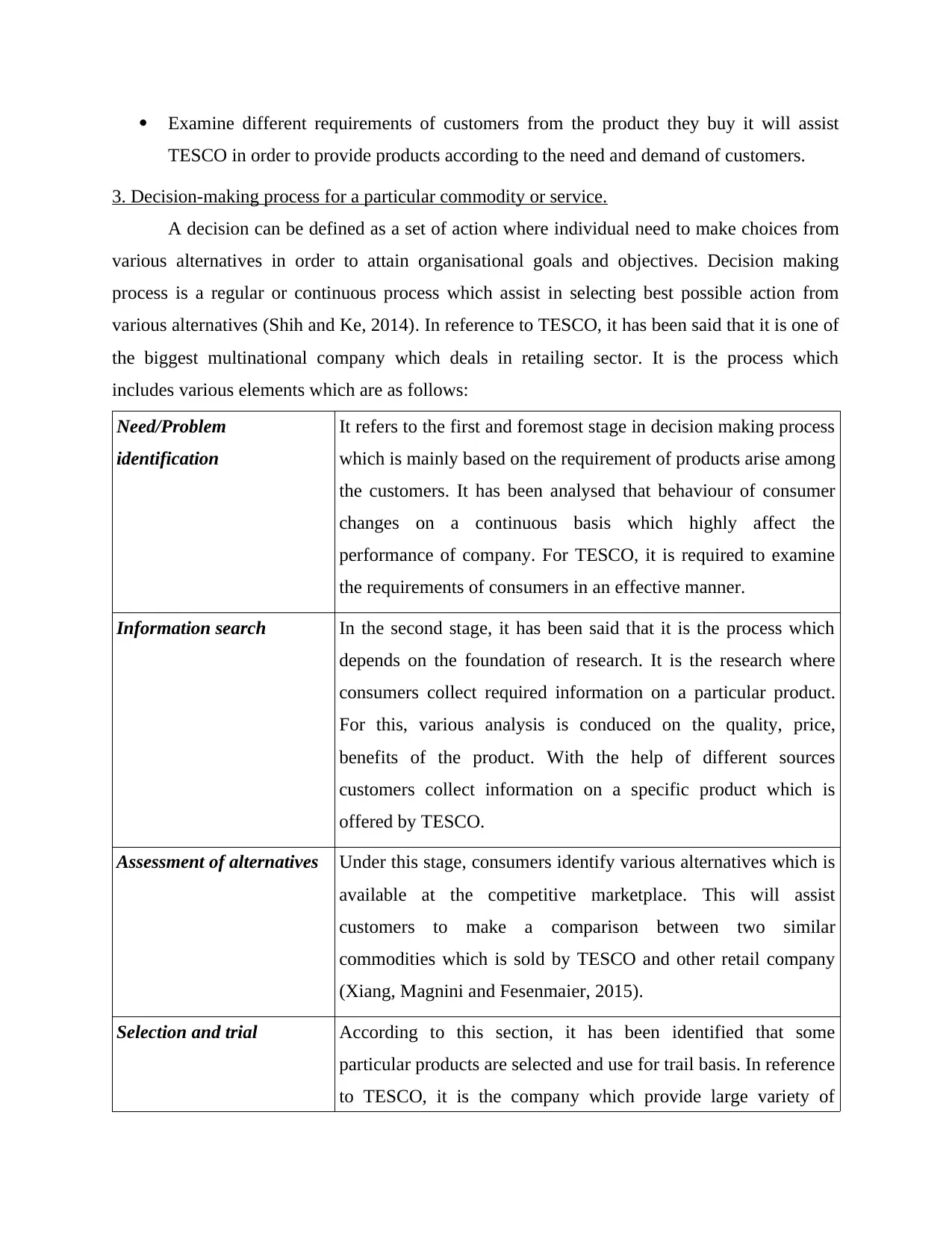
Examine different requirements of customers from the product they buy it will assist
TESCO in order to provide products according to the need and demand of customers.
3. Decision-making process for a particular commodity or service.
A decision can be defined as a set of action where individual need to make choices from
various alternatives in order to attain organisational goals and objectives. Decision making
process is a regular or continuous process which assist in selecting best possible action from
various alternatives (Shih and Ke, 2014). In reference to TESCO, it has been said that it is one of
the biggest multinational company which deals in retailing sector. It is the process which
includes various elements which are as follows:
Need/Problem
identification
It refers to the first and foremost stage in decision making process
which is mainly based on the requirement of products arise among
the customers. It has been analysed that behaviour of consumer
changes on a continuous basis which highly affect the
performance of company. For TESCO, it is required to examine
the requirements of consumers in an effective manner.
Information search In the second stage, it has been said that it is the process which
depends on the foundation of research. It is the research where
consumers collect required information on a particular product.
For this, various analysis is conduced on the quality, price,
benefits of the product. With the help of different sources
customers collect information on a specific product which is
offered by TESCO.
Assessment of alternatives Under this stage, consumers identify various alternatives which is
available at the competitive marketplace. This will assist
customers to make a comparison between two similar
commodities which is sold by TESCO and other retail company
(Xiang, Magnini and Fesenmaier, 2015).
Selection and trial According to this section, it has been identified that some
particular products are selected and use for trail basis. In reference
to TESCO, it is the company which provide large variety of
TESCO in order to provide products according to the need and demand of customers.
3. Decision-making process for a particular commodity or service.
A decision can be defined as a set of action where individual need to make choices from
various alternatives in order to attain organisational goals and objectives. Decision making
process is a regular or continuous process which assist in selecting best possible action from
various alternatives (Shih and Ke, 2014). In reference to TESCO, it has been said that it is one of
the biggest multinational company which deals in retailing sector. It is the process which
includes various elements which are as follows:
Need/Problem
identification
It refers to the first and foremost stage in decision making process
which is mainly based on the requirement of products arise among
the customers. It has been analysed that behaviour of consumer
changes on a continuous basis which highly affect the
performance of company. For TESCO, it is required to examine
the requirements of consumers in an effective manner.
Information search In the second stage, it has been said that it is the process which
depends on the foundation of research. It is the research where
consumers collect required information on a particular product.
For this, various analysis is conduced on the quality, price,
benefits of the product. With the help of different sources
customers collect information on a specific product which is
offered by TESCO.
Assessment of alternatives Under this stage, consumers identify various alternatives which is
available at the competitive marketplace. This will assist
customers to make a comparison between two similar
commodities which is sold by TESCO and other retail company
(Xiang, Magnini and Fesenmaier, 2015).
Selection and trial According to this section, it has been identified that some
particular products are selected and use for trail basis. In reference
to TESCO, it is the company which provide large variety of
⊘ This is a preview!⊘
Do you want full access?
Subscribe today to unlock all pages.

Trusted by 1+ million students worldwide
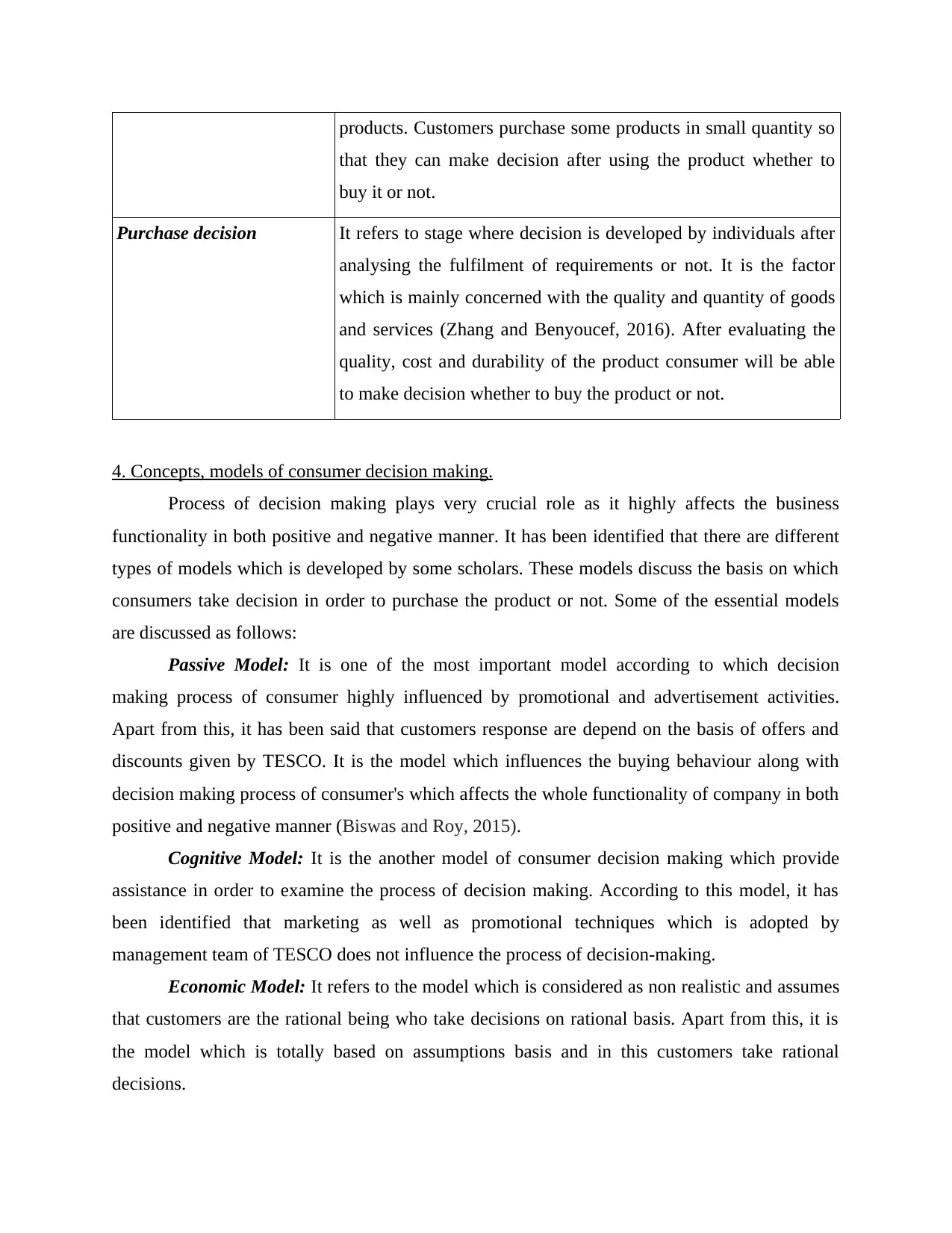
products. Customers purchase some products in small quantity so
that they can make decision after using the product whether to
buy it or not.
Purchase decision It refers to stage where decision is developed by individuals after
analysing the fulfilment of requirements or not. It is the factor
which is mainly concerned with the quality and quantity of goods
and services (Zhang and Benyoucef, 2016). After evaluating the
quality, cost and durability of the product consumer will be able
to make decision whether to buy the product or not.
4. Concepts, models of consumer decision making.
Process of decision making plays very crucial role as it highly affects the business
functionality in both positive and negative manner. It has been identified that there are different
types of models which is developed by some scholars. These models discuss the basis on which
consumers take decision in order to purchase the product or not. Some of the essential models
are discussed as follows:
Passive Model: It is one of the most important model according to which decision
making process of consumer highly influenced by promotional and advertisement activities.
Apart from this, it has been said that customers response are depend on the basis of offers and
discounts given by TESCO. It is the model which influences the buying behaviour along with
decision making process of consumer's which affects the whole functionality of company in both
positive and negative manner (Biswas and Roy, 2015).
Cognitive Model: It is the another model of consumer decision making which provide
assistance in order to examine the process of decision making. According to this model, it has
been identified that marketing as well as promotional techniques which is adopted by
management team of TESCO does not influence the process of decision-making.
Economic Model: It refers to the model which is considered as non realistic and assumes
that customers are the rational being who take decisions on rational basis. Apart from this, it is
the model which is totally based on assumptions basis and in this customers take rational
decisions.
that they can make decision after using the product whether to
buy it or not.
Purchase decision It refers to stage where decision is developed by individuals after
analysing the fulfilment of requirements or not. It is the factor
which is mainly concerned with the quality and quantity of goods
and services (Zhang and Benyoucef, 2016). After evaluating the
quality, cost and durability of the product consumer will be able
to make decision whether to buy the product or not.
4. Concepts, models of consumer decision making.
Process of decision making plays very crucial role as it highly affects the business
functionality in both positive and negative manner. It has been identified that there are different
types of models which is developed by some scholars. These models discuss the basis on which
consumers take decision in order to purchase the product or not. Some of the essential models
are discussed as follows:
Passive Model: It is one of the most important model according to which decision
making process of consumer highly influenced by promotional and advertisement activities.
Apart from this, it has been said that customers response are depend on the basis of offers and
discounts given by TESCO. It is the model which influences the buying behaviour along with
decision making process of consumer's which affects the whole functionality of company in both
positive and negative manner (Biswas and Roy, 2015).
Cognitive Model: It is the another model of consumer decision making which provide
assistance in order to examine the process of decision making. According to this model, it has
been identified that marketing as well as promotional techniques which is adopted by
management team of TESCO does not influence the process of decision-making.
Economic Model: It refers to the model which is considered as non realistic and assumes
that customers are the rational being who take decisions on rational basis. Apart from this, it is
the model which is totally based on assumptions basis and in this customers take rational
decisions.
Paraphrase This Document
Need a fresh take? Get an instant paraphrase of this document with our AI Paraphraser
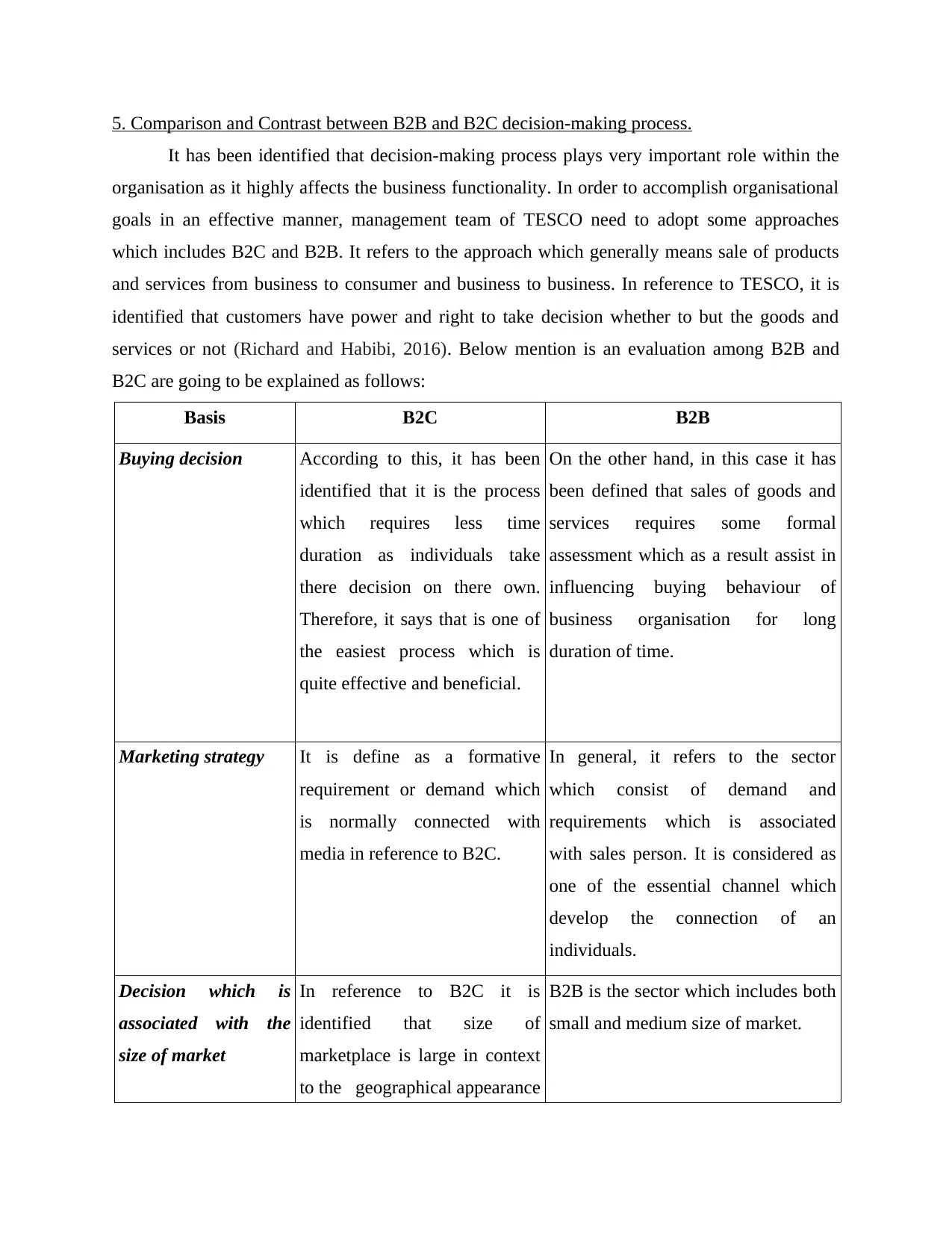
5. Comparison and Contrast between B2B and B2C decision-making process.
It has been identified that decision-making process plays very important role within the
organisation as it highly affects the business functionality. In order to accomplish organisational
goals in an effective manner, management team of TESCO need to adopt some approaches
which includes B2C and B2B. It refers to the approach which generally means sale of products
and services from business to consumer and business to business. In reference to TESCO, it is
identified that customers have power and right to take decision whether to but the goods and
services or not (Richard and Habibi, 2016). Below mention is an evaluation among B2B and
B2C are going to be explained as follows:
Basis B2C B2B
Buying decision According to this, it has been
identified that it is the process
which requires less time
duration as individuals take
there decision on there own.
Therefore, it says that is one of
the easiest process which is
quite effective and beneficial.
On the other hand, in this case it has
been defined that sales of goods and
services requires some formal
assessment which as a result assist in
influencing buying behaviour of
business organisation for long
duration of time.
Marketing strategy It is define as a formative
requirement or demand which
is normally connected with
media in reference to B2C.
In general, it refers to the sector
which consist of demand and
requirements which is associated
with sales person. It is considered as
one of the essential channel which
develop the connection of an
individuals.
Decision which is
associated with the
size of market
In reference to B2C it is
identified that size of
marketplace is large in context
to the geographical appearance
B2B is the sector which includes both
small and medium size of market.
It has been identified that decision-making process plays very important role within the
organisation as it highly affects the business functionality. In order to accomplish organisational
goals in an effective manner, management team of TESCO need to adopt some approaches
which includes B2C and B2B. It refers to the approach which generally means sale of products
and services from business to consumer and business to business. In reference to TESCO, it is
identified that customers have power and right to take decision whether to but the goods and
services or not (Richard and Habibi, 2016). Below mention is an evaluation among B2B and
B2C are going to be explained as follows:
Basis B2C B2B
Buying decision According to this, it has been
identified that it is the process
which requires less time
duration as individuals take
there decision on there own.
Therefore, it says that is one of
the easiest process which is
quite effective and beneficial.
On the other hand, in this case it has
been defined that sales of goods and
services requires some formal
assessment which as a result assist in
influencing buying behaviour of
business organisation for long
duration of time.
Marketing strategy It is define as a formative
requirement or demand which
is normally connected with
media in reference to B2C.
In general, it refers to the sector
which consist of demand and
requirements which is associated
with sales person. It is considered as
one of the essential channel which
develop the connection of an
individuals.
Decision which is
associated with the
size of market
In reference to B2C it is
identified that size of
marketplace is large in context
to the geographical appearance
B2B is the sector which includes both
small and medium size of market.
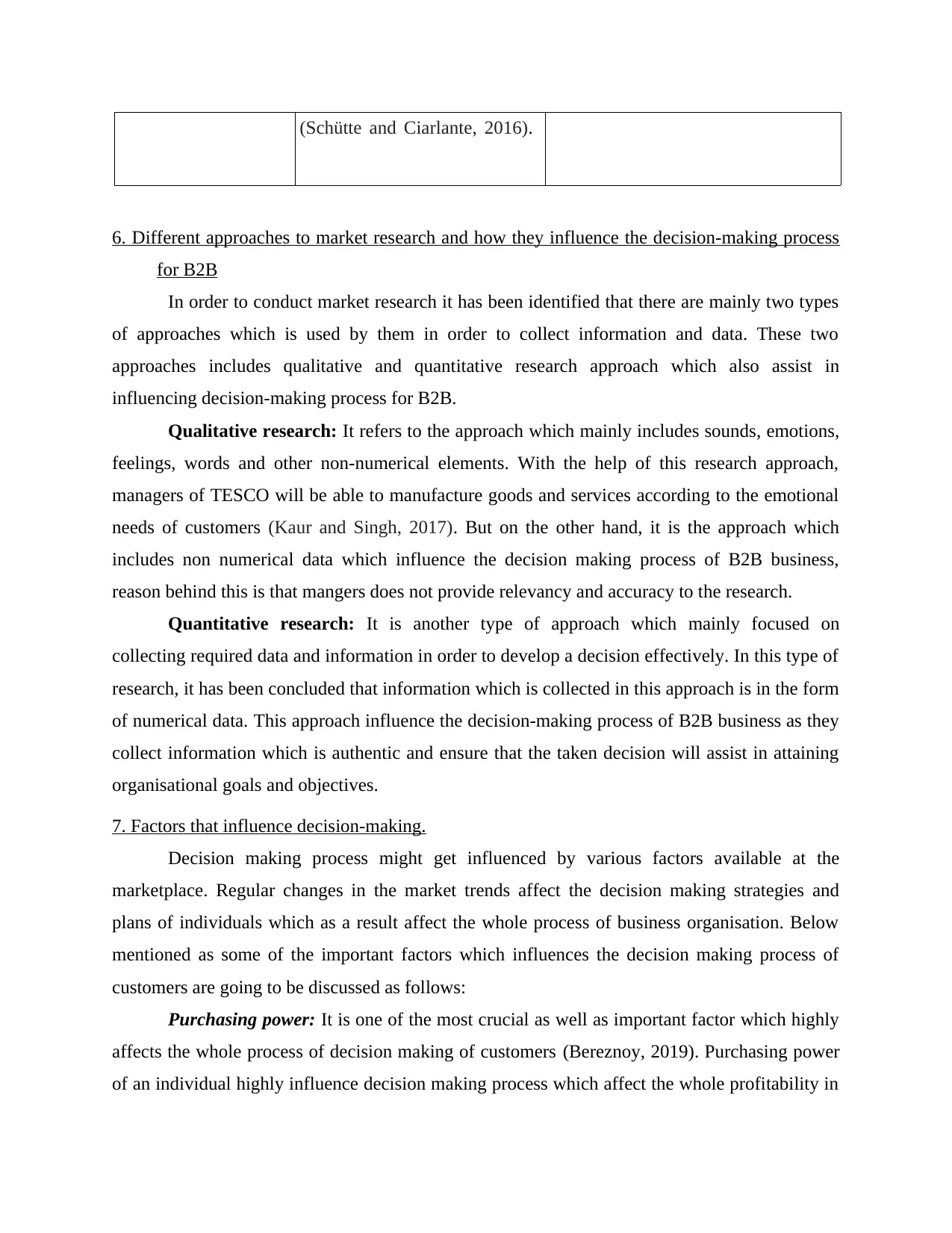
(Schütte and Ciarlante, 2016).
6. Different approaches to market research and how they influence the decision-making process
for B2B
In order to conduct market research it has been identified that there are mainly two types
of approaches which is used by them in order to collect information and data. These two
approaches includes qualitative and quantitative research approach which also assist in
influencing decision-making process for B2B.
Qualitative research: It refers to the approach which mainly includes sounds, emotions,
feelings, words and other non-numerical elements. With the help of this research approach,
managers of TESCO will be able to manufacture goods and services according to the emotional
needs of customers (Kaur and Singh, 2017). But on the other hand, it is the approach which
includes non numerical data which influence the decision making process of B2B business,
reason behind this is that mangers does not provide relevancy and accuracy to the research.
Quantitative research: It is another type of approach which mainly focused on
collecting required data and information in order to develop a decision effectively. In this type of
research, it has been concluded that information which is collected in this approach is in the form
of numerical data. This approach influence the decision-making process of B2B business as they
collect information which is authentic and ensure that the taken decision will assist in attaining
organisational goals and objectives.
7. Factors that influence decision-making.
Decision making process might get influenced by various factors available at the
marketplace. Regular changes in the market trends affect the decision making strategies and
plans of individuals which as a result affect the whole process of business organisation. Below
mentioned as some of the important factors which influences the decision making process of
customers are going to be discussed as follows:
Purchasing power: It is one of the most crucial as well as important factor which highly
affects the whole process of decision making of customers (Bereznoy, 2019). Purchasing power
of an individual highly influence decision making process which affect the whole profitability in
6. Different approaches to market research and how they influence the decision-making process
for B2B
In order to conduct market research it has been identified that there are mainly two types
of approaches which is used by them in order to collect information and data. These two
approaches includes qualitative and quantitative research approach which also assist in
influencing decision-making process for B2B.
Qualitative research: It refers to the approach which mainly includes sounds, emotions,
feelings, words and other non-numerical elements. With the help of this research approach,
managers of TESCO will be able to manufacture goods and services according to the emotional
needs of customers (Kaur and Singh, 2017). But on the other hand, it is the approach which
includes non numerical data which influence the decision making process of B2B business,
reason behind this is that mangers does not provide relevancy and accuracy to the research.
Quantitative research: It is another type of approach which mainly focused on
collecting required data and information in order to develop a decision effectively. In this type of
research, it has been concluded that information which is collected in this approach is in the form
of numerical data. This approach influence the decision-making process of B2B business as they
collect information which is authentic and ensure that the taken decision will assist in attaining
organisational goals and objectives.
7. Factors that influence decision-making.
Decision making process might get influenced by various factors available at the
marketplace. Regular changes in the market trends affect the decision making strategies and
plans of individuals which as a result affect the whole process of business organisation. Below
mentioned as some of the important factors which influences the decision making process of
customers are going to be discussed as follows:
Purchasing power: It is one of the most crucial as well as important factor which highly
affects the whole process of decision making of customers (Bereznoy, 2019). Purchasing power
of an individual highly influence decision making process which affect the whole profitability in
⊘ This is a preview!⊘
Do you want full access?
Subscribe today to unlock all pages.

Trusted by 1+ million students worldwide
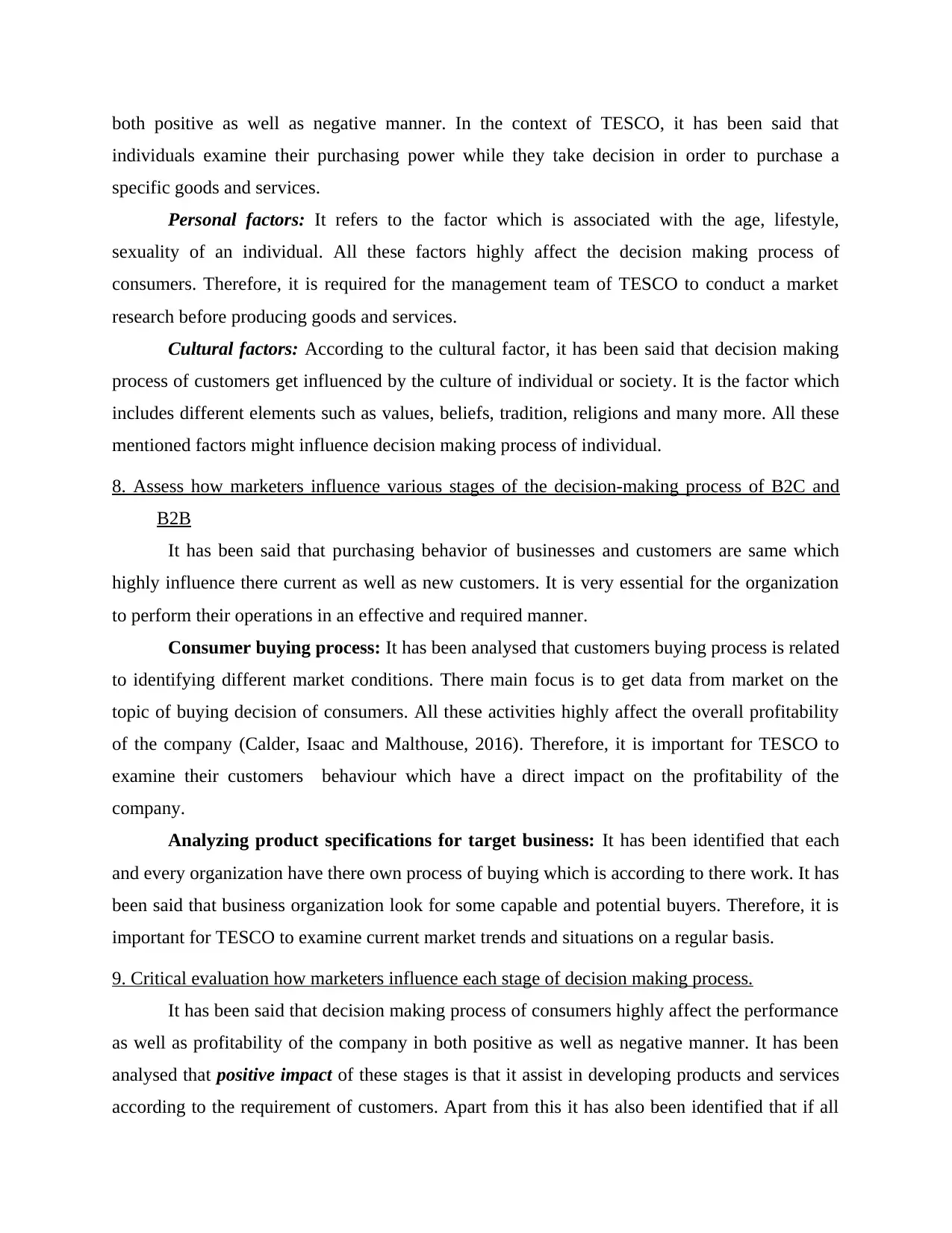
both positive as well as negative manner. In the context of TESCO, it has been said that
individuals examine their purchasing power while they take decision in order to purchase a
specific goods and services.
Personal factors: It refers to the factor which is associated with the age, lifestyle,
sexuality of an individual. All these factors highly affect the decision making process of
consumers. Therefore, it is required for the management team of TESCO to conduct a market
research before producing goods and services.
Cultural factors: According to the cultural factor, it has been said that decision making
process of customers get influenced by the culture of individual or society. It is the factor which
includes different elements such as values, beliefs, tradition, religions and many more. All these
mentioned factors might influence decision making process of individual.
8. Assess how marketers influence various stages of the decision-making process of B2C and
B2B
It has been said that purchasing behavior of businesses and customers are same which
highly influence there current as well as new customers. It is very essential for the organization
to perform their operations in an effective and required manner.
Consumer buying process: It has been analysed that customers buying process is related
to identifying different market conditions. There main focus is to get data from market on the
topic of buying decision of consumers. All these activities highly affect the overall profitability
of the company (Calder, Isaac and Malthouse, 2016). Therefore, it is important for TESCO to
examine their customers behaviour which have a direct impact on the profitability of the
company.
Analyzing product specifications for target business: It has been identified that each
and every organization have there own process of buying which is according to there work. It has
been said that business organization look for some capable and potential buyers. Therefore, it is
important for TESCO to examine current market trends and situations on a regular basis.
9. Critical evaluation how marketers influence each stage of decision making process.
It has been said that decision making process of consumers highly affect the performance
as well as profitability of the company in both positive as well as negative manner. It has been
analysed that positive impact of these stages is that it assist in developing products and services
according to the requirement of customers. Apart from this it has also been identified that if all
individuals examine their purchasing power while they take decision in order to purchase a
specific goods and services.
Personal factors: It refers to the factor which is associated with the age, lifestyle,
sexuality of an individual. All these factors highly affect the decision making process of
consumers. Therefore, it is required for the management team of TESCO to conduct a market
research before producing goods and services.
Cultural factors: According to the cultural factor, it has been said that decision making
process of customers get influenced by the culture of individual or society. It is the factor which
includes different elements such as values, beliefs, tradition, religions and many more. All these
mentioned factors might influence decision making process of individual.
8. Assess how marketers influence various stages of the decision-making process of B2C and
B2B
It has been said that purchasing behavior of businesses and customers are same which
highly influence there current as well as new customers. It is very essential for the organization
to perform their operations in an effective and required manner.
Consumer buying process: It has been analysed that customers buying process is related
to identifying different market conditions. There main focus is to get data from market on the
topic of buying decision of consumers. All these activities highly affect the overall profitability
of the company (Calder, Isaac and Malthouse, 2016). Therefore, it is important for TESCO to
examine their customers behaviour which have a direct impact on the profitability of the
company.
Analyzing product specifications for target business: It has been identified that each
and every organization have there own process of buying which is according to there work. It has
been said that business organization look for some capable and potential buyers. Therefore, it is
important for TESCO to examine current market trends and situations on a regular basis.
9. Critical evaluation how marketers influence each stage of decision making process.
It has been said that decision making process of consumers highly affect the performance
as well as profitability of the company in both positive as well as negative manner. It has been
analysed that positive impact of these stages is that it assist in developing products and services
according to the requirement of customers. Apart from this it has also been identified that if all
Paraphrase This Document
Need a fresh take? Get an instant paraphrase of this document with our AI Paraphraser
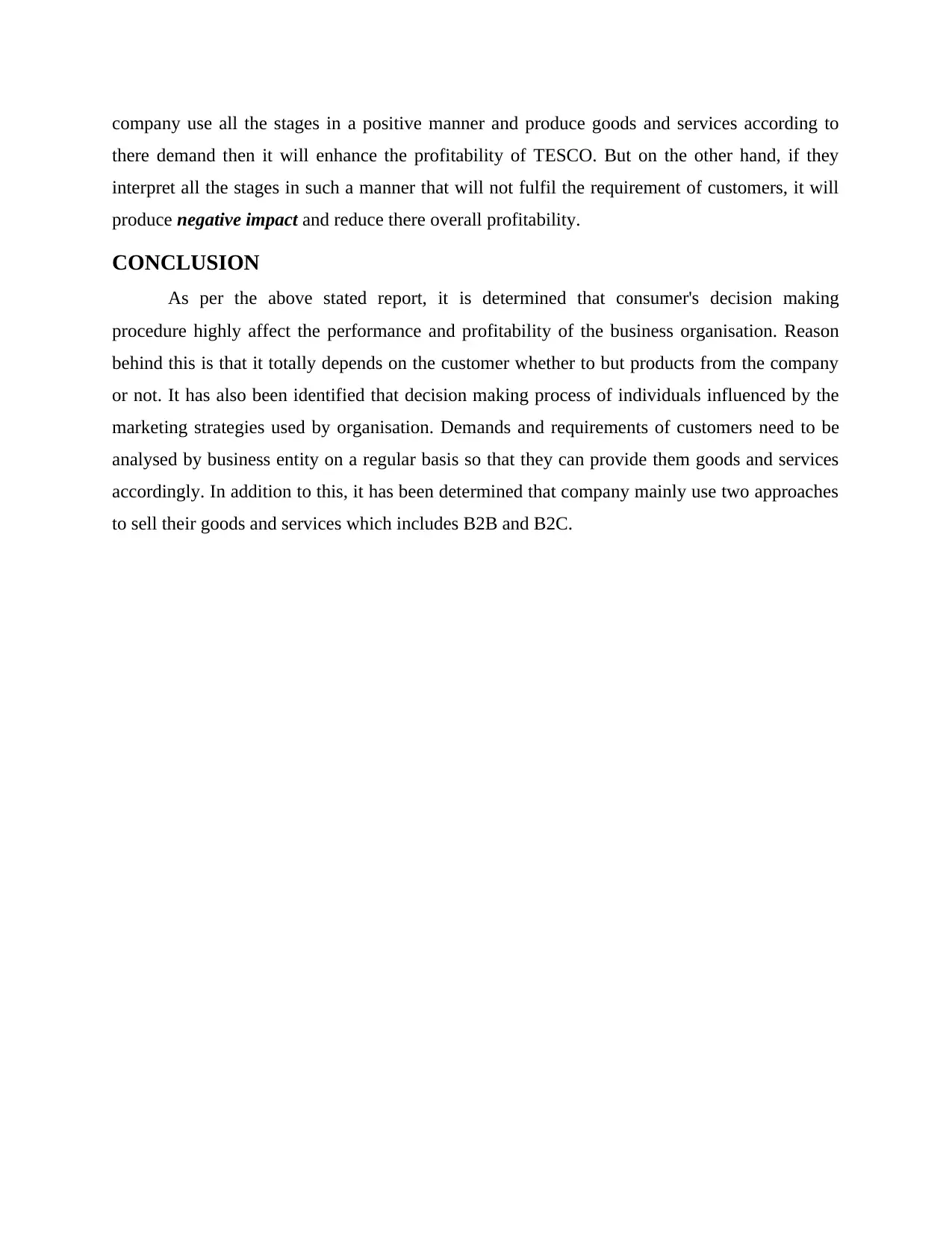
company use all the stages in a positive manner and produce goods and services according to
there demand then it will enhance the profitability of TESCO. But on the other hand, if they
interpret all the stages in such a manner that will not fulfil the requirement of customers, it will
produce negative impact and reduce there overall profitability.
CONCLUSION
As per the above stated report, it is determined that consumer's decision making
procedure highly affect the performance and profitability of the business organisation. Reason
behind this is that it totally depends on the customer whether to but products from the company
or not. It has also been identified that decision making process of individuals influenced by the
marketing strategies used by organisation. Demands and requirements of customers need to be
analysed by business entity on a regular basis so that they can provide them goods and services
accordingly. In addition to this, it has been determined that company mainly use two approaches
to sell their goods and services which includes B2B and B2C.
there demand then it will enhance the profitability of TESCO. But on the other hand, if they
interpret all the stages in such a manner that will not fulfil the requirement of customers, it will
produce negative impact and reduce there overall profitability.
CONCLUSION
As per the above stated report, it is determined that consumer's decision making
procedure highly affect the performance and profitability of the business organisation. Reason
behind this is that it totally depends on the customer whether to but products from the company
or not. It has also been identified that decision making process of individuals influenced by the
marketing strategies used by organisation. Demands and requirements of customers need to be
analysed by business entity on a regular basis so that they can provide them goods and services
accordingly. In addition to this, it has been determined that company mainly use two approaches
to sell their goods and services which includes B2B and B2C.
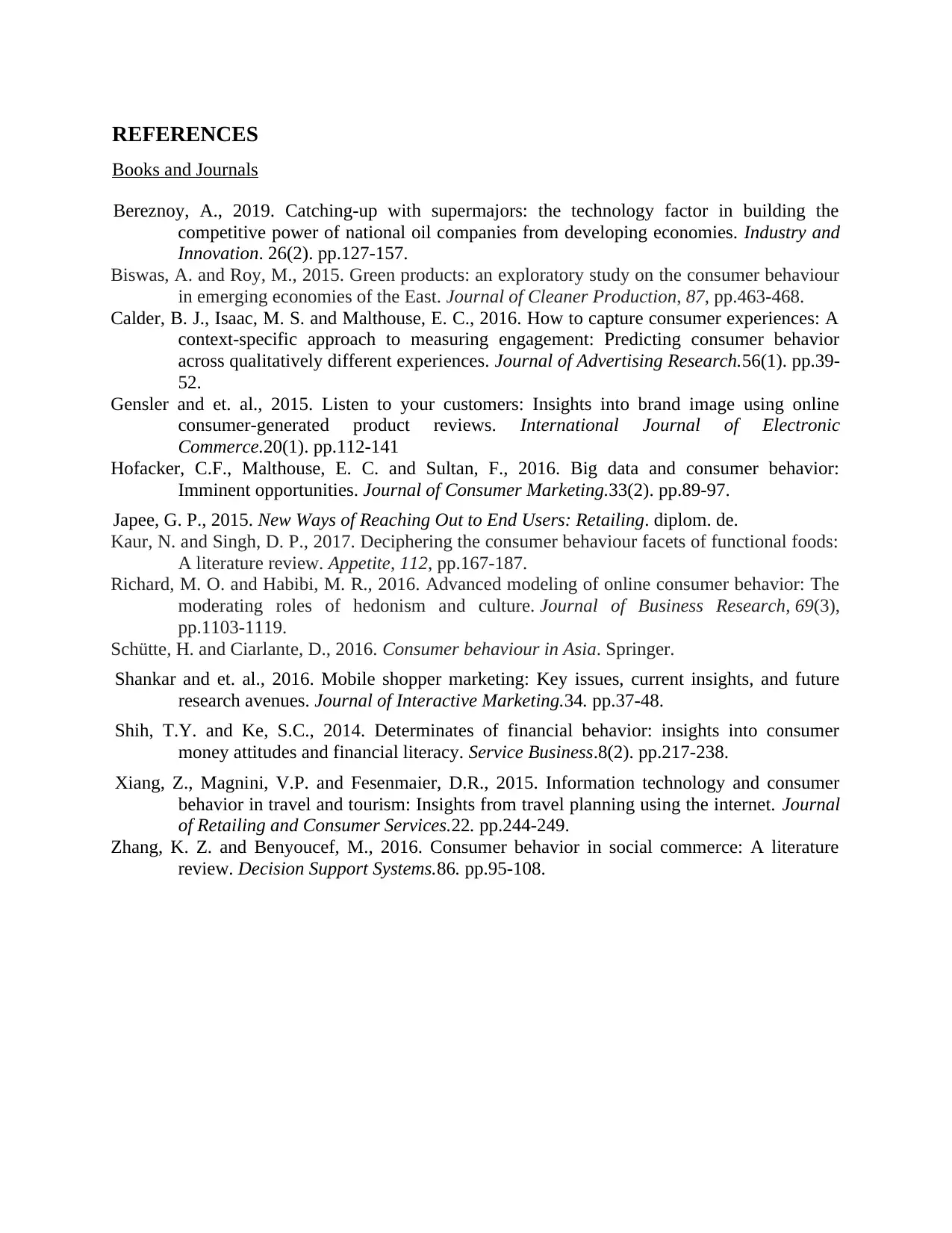
REFERENCES
Books and Journals
Bereznoy, A., 2019. Catching-up with supermajors: the technology factor in building the
competitive power of national oil companies from developing economies. Industry and
Innovation. 26(2). pp.127-157.
Biswas, A. and Roy, M., 2015. Green products: an exploratory study on the consumer behaviour
in emerging economies of the East. Journal of Cleaner Production, 87, pp.463-468.
Calder, B. J., Isaac, M. S. and Malthouse, E. C., 2016. How to capture consumer experiences: A
context-specific approach to measuring engagement: Predicting consumer behavior
across qualitatively different experiences. Journal of Advertising Research.56(1). pp.39-
52.
Gensler and et. al., 2015. Listen to your customers: Insights into brand image using online
consumer-generated product reviews. International Journal of Electronic
Commerce.20(1). pp.112-141
Hofacker, C.F., Malthouse, E. C. and Sultan, F., 2016. Big data and consumer behavior:
Imminent opportunities. Journal of Consumer Marketing.33(2). pp.89-97.
Japee, G. P., 2015. New Ways of Reaching Out to End Users: Retailing. diplom. de.
Kaur, N. and Singh, D. P., 2017. Deciphering the consumer behaviour facets of functional foods:
A literature review. Appetite, 112, pp.167-187.
Richard, M. O. and Habibi, M. R., 2016. Advanced modeling of online consumer behavior: The
moderating roles of hedonism and culture. Journal of Business Research, 69(3),
pp.1103-1119.
Schütte, H. and Ciarlante, D., 2016. Consumer behaviour in Asia. Springer.
Shankar and et. al., 2016. Mobile shopper marketing: Key issues, current insights, and future
research avenues. Journal of Interactive Marketing.34. pp.37-48.
Shih, T.Y. and Ke, S.C., 2014. Determinates of financial behavior: insights into consumer
money attitudes and financial literacy. Service Business.8(2). pp.217-238.
Xiang, Z., Magnini, V.P. and Fesenmaier, D.R., 2015. Information technology and consumer
behavior in travel and tourism: Insights from travel planning using the internet. Journal
of Retailing and Consumer Services.22. pp.244-249.
Zhang, K. Z. and Benyoucef, M., 2016. Consumer behavior in social commerce: A literature
review. Decision Support Systems.86. pp.95-108.
Books and Journals
Bereznoy, A., 2019. Catching-up with supermajors: the technology factor in building the
competitive power of national oil companies from developing economies. Industry and
Innovation. 26(2). pp.127-157.
Biswas, A. and Roy, M., 2015. Green products: an exploratory study on the consumer behaviour
in emerging economies of the East. Journal of Cleaner Production, 87, pp.463-468.
Calder, B. J., Isaac, M. S. and Malthouse, E. C., 2016. How to capture consumer experiences: A
context-specific approach to measuring engagement: Predicting consumer behavior
across qualitatively different experiences. Journal of Advertising Research.56(1). pp.39-
52.
Gensler and et. al., 2015. Listen to your customers: Insights into brand image using online
consumer-generated product reviews. International Journal of Electronic
Commerce.20(1). pp.112-141
Hofacker, C.F., Malthouse, E. C. and Sultan, F., 2016. Big data and consumer behavior:
Imminent opportunities. Journal of Consumer Marketing.33(2). pp.89-97.
Japee, G. P., 2015. New Ways of Reaching Out to End Users: Retailing. diplom. de.
Kaur, N. and Singh, D. P., 2017. Deciphering the consumer behaviour facets of functional foods:
A literature review. Appetite, 112, pp.167-187.
Richard, M. O. and Habibi, M. R., 2016. Advanced modeling of online consumer behavior: The
moderating roles of hedonism and culture. Journal of Business Research, 69(3),
pp.1103-1119.
Schütte, H. and Ciarlante, D., 2016. Consumer behaviour in Asia. Springer.
Shankar and et. al., 2016. Mobile shopper marketing: Key issues, current insights, and future
research avenues. Journal of Interactive Marketing.34. pp.37-48.
Shih, T.Y. and Ke, S.C., 2014. Determinates of financial behavior: insights into consumer
money attitudes and financial literacy. Service Business.8(2). pp.217-238.
Xiang, Z., Magnini, V.P. and Fesenmaier, D.R., 2015. Information technology and consumer
behavior in travel and tourism: Insights from travel planning using the internet. Journal
of Retailing and Consumer Services.22. pp.244-249.
Zhang, K. Z. and Benyoucef, M., 2016. Consumer behavior in social commerce: A literature
review. Decision Support Systems.86. pp.95-108.
⊘ This is a preview!⊘
Do you want full access?
Subscribe today to unlock all pages.

Trusted by 1+ million students worldwide
1 out of 15
Related Documents
Your All-in-One AI-Powered Toolkit for Academic Success.
+13062052269
info@desklib.com
Available 24*7 on WhatsApp / Email
![[object Object]](/_next/static/media/star-bottom.7253800d.svg)
Unlock your academic potential
Copyright © 2020–2025 A2Z Services. All Rights Reserved. Developed and managed by ZUCOL.





